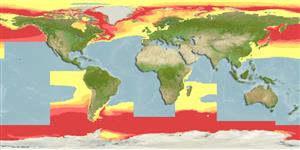Eukrohnia hamata (Möbius, 1875)
| Native range | All suitable habitat | Point map | Year 2050 |

|
| This map was computer-generated and has not yet been reviewed. |
| Eukrohnia hamata AquaMaps Data sources: GBIF OBIS |
Classification / Names Common names | Synonyms | CoL | ITIS | WoRMS
Sagittoidea | Phragmophora | Eukrohniidae
Environment: milieu / climate zone / depth range / distribution range Ecology
Pelagic-oceanic; depth range 0 - 3000 m (Ref. 1812). Temperate; -2°C - 17°C (Ref. 1705); 80°N - 76°S, 0°E - 0°E
Distribution Countries | FAO areas | Ecosystems | Occurrences | Introductions
Arctic, Atlantic, Indo-Pacific and the Antarctic. Common in Southeast Pacific.
Length at first maturity / Size / Weight / Age
Maturity: Lm ? range ? - ? cm Max length : 4.3 cm BL male/unsexed; (Ref. 2255)
Life cycle and mating behavior Maturity | Reproduction | Spawning | Eggs | Fecundity | Larvae
Main reference
References | Coordinator | Collaborators
Hansson, H.G. 1998 NEAT (North East Atlantic Taxa): South Scandinavian marine "Aschelminth" (except Nematoda, which are treated separately and some other species poor phyla Check-List. Internet pdf Ed., http://www.tmbl.gu.se (Ref. 429)
IUCN Red List Status
(Ref. 130435: Version 2025-1)
CITES status (Ref. 108899)
CMS (Ref. 116361)
Threat to humans
Human uses
| FishSource |
Tools
More information
Max. ages / sizes
Length-weight rel.
Length-length rel.
Length-frequencies
Mass conversion
Abundance
Internet sources
BHL | BOLD Systems | CISTI | DiscoverLife | FAO(Publication : search) | Fishipedia | GenBank (genome, nucleotide) | GloBI | Gomexsi | Google Books | Google Scholar | Google | PubMed | Tree of Life | Wikipedia (Go, Search) | Zoological Record



